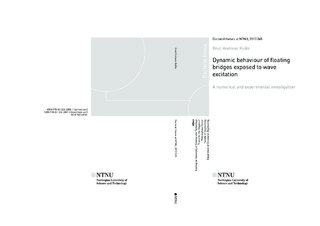| dc.contributor.author | Kvåle, Knut Andreas | |
| dc.date.accessioned | 2018-01-23T14:50:47Z | |
| dc.date.available | 2018-01-23T14:50:47Z | |
| dc.date.issued | 2017 | |
| dc.identifier.isbn | 978-82-326-2801-8 | |
| dc.identifier.issn | 1503-8181 | |
| dc.identifier.uri | http://hdl.handle.net/11250/2479175 | |
| dc.description.abstract | By utilizing the buoyancy of the water in a crossing, floating bridges may provide permanent road links where other bridge types would be impossible or too costly to build. Still, floating bridges are not wide-spread in modern road infrastructure. One major issue in this regard is the lack of available information about the performance of existing floating bridges, and consequently, how well the numerical prediction methodology enables an accurate description of their real-life behaviour. The fluid-structure interaction combined with dynamic and stochastic excitation makes numerical prediction of floating bridges a complex problem.
A better understanding of the dynamic behaviour of floating bridges would be highly valuable for the design of new floating bridges. The accuracy of the numerical prediction methodology is a crucial consideration for both the general trust in the numerical models, but also for reducing the required safety margins in designs.
This dissertation concerns the issues listed above by means of numerical modelling using stateof- the-art methodology and a comprehensive monitoring system installed on the Bergsøysund Bridge, an existing floating pontoon bridge. The dynamic response of the Bergsøysund Bridge is predicted within the framework of the finite element method and compared with the measured response. Furthermore, by applying operational modal analysis, the modal parameters are determined experimentally from the recorded data, and compared with the modal parameters resulting from the solution of the eigenvalue problem of the numerical model.
For realistic sea states, the case study reveals that the response is only weakly dependent on the directional spreading of the wave field. Furthermore, the correlation between the wave excitation at the different pontoons is very low, such that the wave spectral density matrix may be approximated to be block-diagonal without significant effects to the resulting response spectral density. The predicted and measured lateral response quantities are for most cases in good agreement. Predictions of the vertical response is not accurate when considering how the energy is distributed over relevant frequencies, but standard deviations are normally accurately predicted. Torsional response is not predicted with a satisfactory accuracy. The operational modal analysis does prove to be challenging. Large damping, closely spaced modes, and an arc-shaped design prone to coupled motion are factors that complicate the task. Modal damping ratios as high as 12–14% are observed both numerically and experimentally. Some of the experimental mode shapes are comprised of a mix of multiple of the predicted mode shapes, where the amount and fashion of the mixing is varying from recording to recording. This may indicate a modal coupling of the mode shapes, which implies that energy is transferred between modes. The variability of the identified natural frequencies drops as the significant wave height, which characterize the excitation level, increases. Furthermore, the damping levels are increasing for increasing excitation level.
Floating bridges are structures prone to complex dynamic behaviour. The importance of verification of numerical models should therefore be emphasized. Due to this, the current work is considered to be relevant for the future development of floating bridges. | |
| dc.language.iso | eng | nb_NO |
| dc.publisher | NTNU | nb_NO |
| dc.relation.ispartofseries | Doctoral theses at NTNU;2017:365 | |
| dc.relation.haspart | Paper 1:
Kvåle, Knut Andreas; Sigbjørnsson, Ragnar; Øiseth, Ole.
Modelling the stochastic dynamic behaviour of a pontoon bridge: A case study. Computers & structures 2016 ;Volum 165. s. 123-135
https://doi.org/10.1016/j.compstruc.2015.12.009 | |
| dc.relation.haspart | Paper 2:
Kvåle, Knut Andreas; Øiseth, Ole.
Structural monitoring of an end-supported pontoon bridge. Marine Structures 2017 ;Volum 52. s. 188-207
https://doi.org/10.1016/j.marstruc.2016.12.004 | |
| dc.relation.haspart | Paper 3:
Kvåle, Knut Andreas; Øiseth, Ole; Rønnquist, Anders.
Operational modal analysis of an end-supported pontoon bridge. Engineering structures 2017 ;Volum 148. s. 410-423
https://doi.org/10.1016/j.engstruct.2017.06.069 | |
| dc.relation.haspart | Paper 4:
K. A. Kvåle and O. Øiseth, “Dynamic response of an end-supported pontoon bridge
due to wave excitation: numerical predictions versus measurements. | |
| dc.relation.haspart | Paper 5:
K. A. Kvåle and O. Øiseth, “Characterization of the wave field around an existing
end-supported pontoon bridge from simulated data - Proceedings of the
International Conference on Earthquake engineering and Structural Dynamics | |
| dc.title | Dynamic behaviour of floating bridges exposed to wave excitation A numerical and experimental investigation | nb_NO |
| dc.type | Doctoral thesis | nb_NO |
| dc.subject.nsi | VDP::Technology: 500::Mechanical engineering: 570::Machine construction and engineering technology: 571 | nb_NO |
